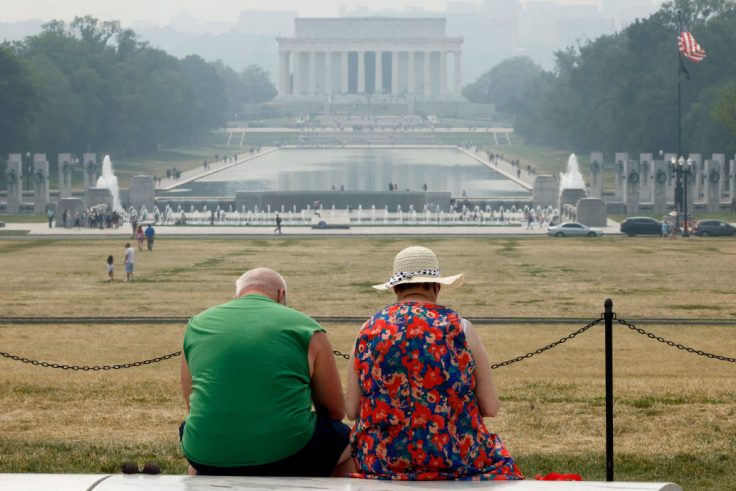Always on the lookout for signs of climate apocalypse, mainstream U.S. media are reacting predictably to Canadian wildfires that last week blanketed their native Northeast in smoke.
But wildfires—and Canadians—have been annoying Americans since before there was an America. What has changed is the media's reflexive attribution of those fires to climate change.
Climate change will increase the chance of severe wildfires like those burning in Canada and heat waves like the one hitting Puerto Rico. This week’s extremes offer a clear takeaway: North America is unprepared for the hazards of the not-too-distant future.https://t.co/YRiyERC6pX
— The New York Times (@nytimes) June 8, 2023
The cloud of smoke inundating the East Coast — fueled by more than 400 active fires burning across Canada, with more than half of them considered 'out of control" — underscored how climate change’s threat to human health can transcend national boundaries. https://t.co/v3rnMLAW8w
— The Washington Post (@washingtonpost) June 8, 2023
.@MichaelEMann tells @ZeeshanAleem that the wildfire crisis is fueled by a "toxic climate change brew" and could be a sign of far worse things to come. https://t.co/uWGPWlNqQo
— MSNBC (@MSNBC) June 7, 2023
The media trumpet data showing that U.S. wildfires have grown more extensive in recent decades. But the frequency and extent of wildfires have trended downward in Canada over that time, according to the country's National Forestry Database. And, zooming out in time, U.S. Forest Service data show that made-in-America wildfires are a fraction as extensive as they were 100 years ago.
![]()
Credit: U.S. Forest Service
A 1912 book, published by the Department of Agriculture, chronicles forest fires in New England and Canada dating back to 1706:
Dark days have been recorded for centuries. Usually there is a gradually increasing gloom until it becomes so dark that artificial light is necessary. This darkness may last a few hours or several days and decrease as gradually as it came.
We are now able to show that dark days are due to dense smoke in the atmosphere, and that in this country forest and prairie fires have been the causes.
The media used to have some sense of historical perspective about wildfires.
1950, South China Morning Post:
The sun was purple in the Eastern United States to-day and the moon was blue, because smoke from the forest fires in Western Canada continued its world-wide travels on high altitude winds. …
[New York chief weatherman Ernie] Christie said the smoke pall was by no means unusual. Its particular heaviness this week was caused by the coincidental occurrence of wide-spread fires and not by unusual trans-continental winds.
Mr. Christie said reports of black snow were not uncommon and it was caused by similar weather conditions which blew coal smoke and cinders up into the snow clouds.
But citizens of Ontario, Iowa, Michigan, Ohio, Pennsylvania, and the Middle Atlantic states watched the sky break out in patches of yellow, brown, pink, purple, and blue-black. …
Major-league baseball parks turned on their floodlights. At Cleveland, where the blackout hit early, an entire afternoon game was played under the lights for the first time in American League history. …
Frank McDougall, [Canada's] deputy minister of lands and forests, said such smoke clouds were not uncommon but were seldom so far-reaching.
But that was then. The harbingers of doom are everywhere now.
Depression, anxiety, PTSD: The mental impact of climate change https://t.co/zjInwo5l8j pic.twitter.com/tyAJeHx6Br
— CNN (@CNN) March 15, 2017
Today’s children are 30% less aerobically fit than their parents were at their age, a new study found.
The study points to climate change and rising temperatures adversely affecting childhood obesity, as children spend less time exercising outdoors. pic.twitter.com/26WehoLK9I
— CBS Mornings (@CBSMornings) August 13, 2022
Research has made it clear: Earth’s warming, the result of the burning of fossil fuels, is increasing the risks of bumpy flights.
Here is what to know about the science behind turbulence and the ways climate change is influencing air travel: https://t.co/236vOx9u1C
— The Washington Post (@washingtonpost) March 4, 2023
Major League Baseball is seeing more home runs and the reason behind this surge is more than just having better players —climate change is playing a part as well according to a new study. https://t.co/wYNkz4jJvM pic.twitter.com/rAoS12ea7G
— The Associated Press (@AP) April 7, 2023
Media climate hysteria blots out coverage of factors that directly contribute to wildfires and that could be more readily addressed, including urban sprawl, reckless recreationalists, and poor forest management.
"Government land management policies that prevent wildfires from spreading out of control...would reduce CO2 emissions more than offshore wind or electric-vehicle mandates. Alas, this doesn’t fit with the climate left’s book of Revelation." https://t.co/8N5VDQKcho
— House Committee on Agriculture (@HouseAgGOP) June 8, 2023
